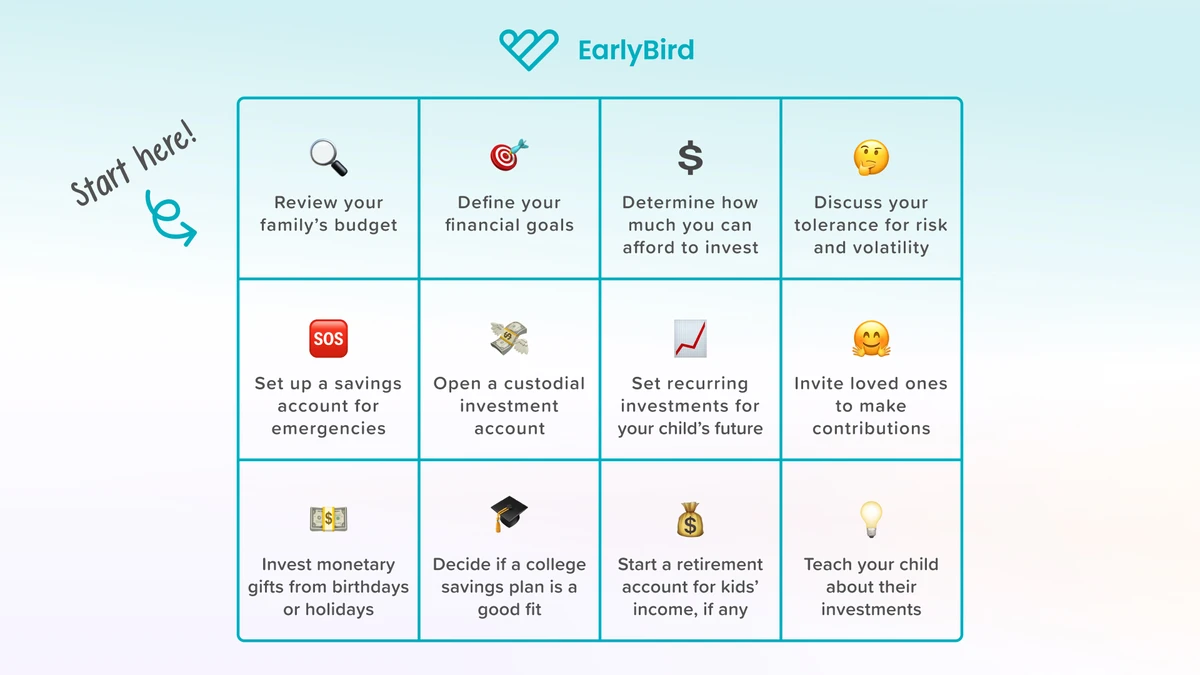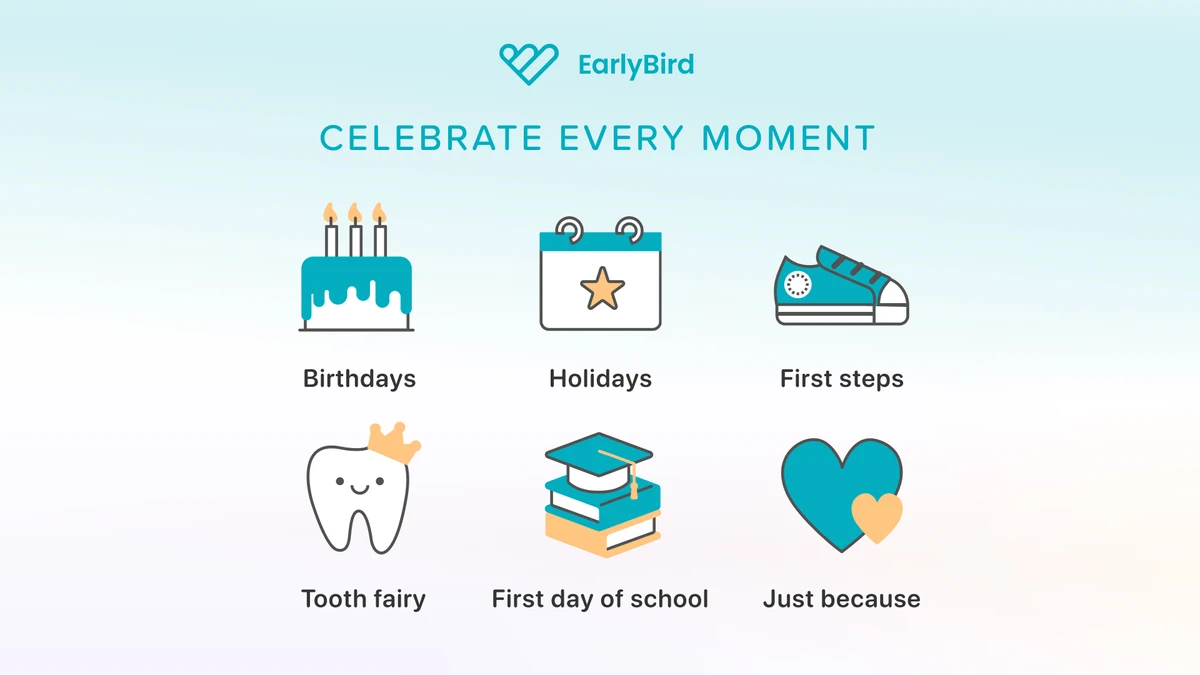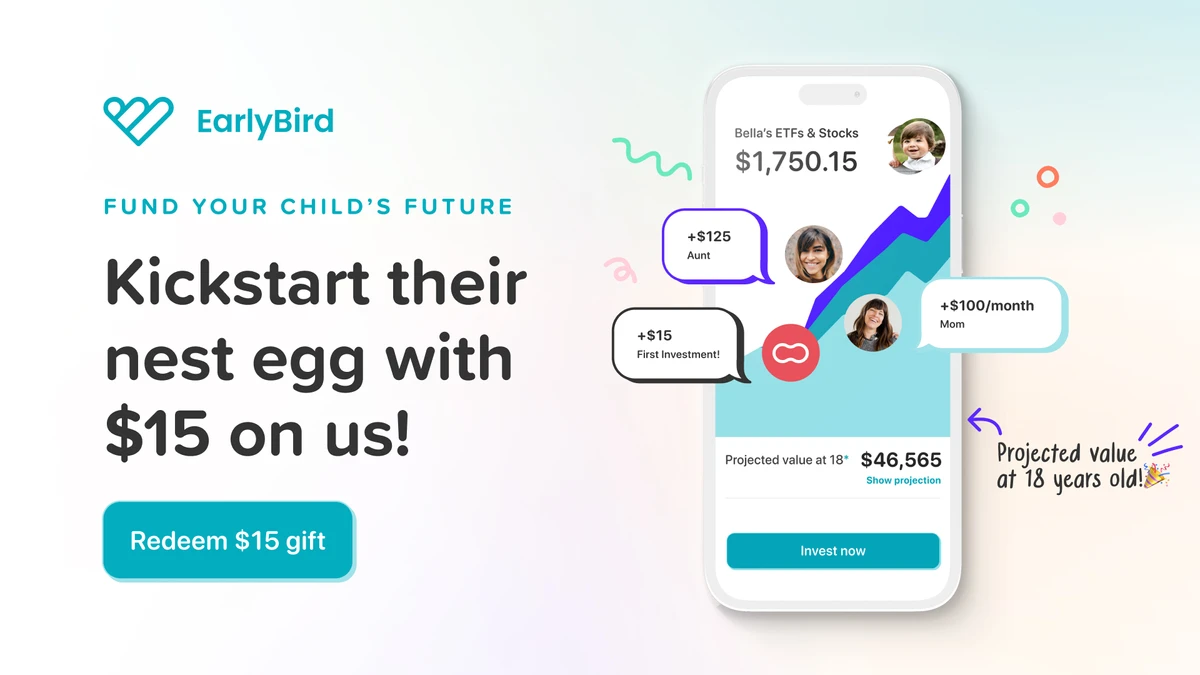This article is written in partnership with EarlyBird, a supporter of Peanut and women alike.
Peanut has teamed up with the family investing app, EarlyBird, to help moms like you do a financial literacy check and set your kiddo up with a head start to fund their future.
We’re also investing $15 in your little one’s account so you can start strong today.
Did you know that more than half of American families aren’t saving for their kids’ futures?
It’s not surprising ‒ with so much on mom’s plate, it’s impossible to give attention to everything.
Financial literacy often gets pushed to the side when it comes to planning for your little one’s best future.
We all want the kids we love to grow up without being weighed down by heavy financial burdens.
Unfortunately, most families just aren’t investing for the future.
If you’re serious about creating a nest egg for your kids, it’s important to get started as soon as you can.
They say the best time to plant a tree was 20 years ago ‒ and the second-best time is today.
The same is true for investing.
Let’s put this into perspective: with $100 invested each month from birth to the age of 18, your child could have over $40K towards college expenses at 18, over $100K to start a business or buy a home at age 30, and over $1M if they hold the funds until retirement, assuming 8% year over year growth.*

In this guide, you’ll learn about some key financial terms, what to consider when choosing investments, the different types of investment accounts available to help you build generational wealth and create a nest egg for your little one followed by a checklist to get you started as a family.
Feeling intimidated? Don’t be!
Lucky for your children, no matter how old they are today, it’s never too late to get started learning and investing.
Financial literacy is a gift you give them for life.
In fact, most Americans say parents are the #1 resource they turn to to learn about managing finance.
Do right by your little ones by setting up their financial foundation and learning the answers to their future burning questions.
Let’s get started!
In this article: 📝
- Your family finance checklist
- Fundamentals of investing
- 3 account types every parent should know about
- How to start your children’s investment account today
Your family finance checklist
Print this out and put it on your fridge as a reminder of your goals!
Don’t worry ‒ we’ll get into what these terms mean. Keep reading!

Fundamentals of investing
Launching an investment account can feel super scary.
Getting a handle on your risk tolerance, time horizon, investment goals, and diversification will help you grow wealth with confidence.
These are fundamentals of investing that will help you go from saying “What the heck?” to “Heck yeah!” when you’re setting up your future investment account.
Risk tolerance
Your risk tolerance describes how much you’re willing to risk losing in order to make gains.
Investing isn’t a sure thing, as there’s always a chance that the assets you’re investing in could decrease in value.
Before you invest, you have to decide how much you’re comfortable risking in pursuit of high returns ‒ and a big part of your risk tolerance tends to link pretty closely to your time horizon.
Time horizon
Your time horizon is the amount of time you’re expecting it to take to reach a specific financial goal.
Generally speaking, you’re working with a longer time horizon when investing for children ‒ and because of this, you can afford to take on a little more risk.
This is essentially because, if your assets do end up dropping in value, you can reconfigure your portfolio as needed, and still have plenty of time to meet your long-term financial targets.
Investment goal
Your investment goal is the reason you’re putting money away.
It might be to save for your child’s wedding, a down payment on a future house, college tuition, or even future retirement.
Whatever your goal, it helps to attach a monetary value, so that you know roughly where you need to be within your allotted investment time horizon.
This will dictate how much risk you’re willing to take on, the vehicles you use to invest, and how much you put toward achieving your goal.
Diversification
Diversification is the process of creating a broad mix of assets within your portfolio, so that if one asset or sector decreases in value, it can be balanced out by other assets that continue to perform well.
By investing in a range of different asset classes or types, you won’t have all your eggs in one basket.
Dollar-cost averaging
Dollar-cost averaging is every investor’s best friend.
Instead of trying to play the market and make lump-sum buys when the market is hot, investors practice buying on a regular basis, regardless of the price of shares.
This not only helps build a great money habit, it also means that you’ll ride the waves of the market (bear and bull alike) and be less affected by volatility. Investing stress: gone.
With EarlyBird, you can schedule recurring investments for your child in addition to gifting big on special occasions.
That means your child will have great habits from the get-go, and you’ll still get to #GiftWealthNotWaste when it matters.
Here are some of our favorite special occasions for gifting:

3 account types every parent should know about
Custodial investment account
Known for their flexibility, UGMA and UTMA accounts allow you to manage a variety of assets on behalf of a child.
A Uniform Gifts to Minors Act (UGMA) custodial account is an investment vehicle an adult can use to store assets for a minor beneficiary.
When you set up a UGMA account, you must manage the assets in that account as its “custodian” until the beneficiary reaches the age of majority in their state ‒ usually either 18 or 21.
Because everything in an UGMA account is the legal property of the minor beneficiary, custodial accounts normally generate tax savings for families, as any unearned income the account generates up to a certain threshold is taxed at the child’s (normally) lower tax rate.
UGMA accounts also don’t have contribution limits.
This means that, thanks to the IRS Gift Tax, you can gift up to $16,000 per year into a child’s account without needing to pay taxes on it.
College savings plan
Unlike UGMA accounts, when you use a 529 Plan or Coverdell ESA to save for the future, those funds can only be used for education.
A 529 is a state-run college savings plan that lets you invest cash in pre-selected mutual funds or ETFs.
The type of securities basket you’re able to invest in will depend on your state.
A major benefit of 529 plans is that all of the money you invest in a 529 grows tax-free.
As long as you’re making withdrawals for “qualified education expenses,” you won’t get taxed.
However, the state definitions of qualified expenses are usually pretty rigid, so you can often only use a 529 plan to pay for tuition, administrative fees, and (sometimes) on-campus accommodation.
If you take money out for anything that’s not on the list, you’ll have to pay both a penalty and a tax on that withdrawal. 529 contribution limits are also normally quite low ‒ which is why many families decide to set up a custodial account alongside a 529 plan.
Custodial retirement account
If your child earns income, you can start saving for their retirement or set aside funds for college. Maximum contributions apply.
A custodial individual retirement account (IRA) is an investment vehicle a parent or guardian can create for a minor who has their own income.
The cash you place into a custodial IRA is then able to grow tax-free over time.
This means you won’t have to pay the IRS for any capital gains, and you won’t get charged to make withdrawals if the beneficiary is of retirement age.
A custodial IRA is, therefore, a very long-term investment to make for a child.
It’s also worth noting that IRAs usually have low contribution limits, and you can’t gift money into the account.
Custodial IRA deposits must be sourced from the child’s own income.
That makes them ideal if your kid earns regular cash babysitting or mowing lawns.
But if you’re trying to set up an investment for a baby or toddler who isn’t earning their own income, a custodial IRA isn’t the right move.
How to start your children’s investment account today
Choosing investments for your child’s future can feel overwhelming.
You want to set them up for success by making investments that will grow enough to help them reach their future goals while presenting minimal risk.
After all, you want to make sure the funds will be there when your child needs them.
Successful investors know that it’s all about consistently investing for many years rather than choosing the perfect investment or the perfect time to buy.
Whether you want to invest for yourself or for your children, now is the time to begin.
Ready to invest?
EarlyBird’s got an exclusive offer for our Peanut community just in time for the holidays!
Open your little one’s investment account with EarlyBird, and we’ll give you a $15 gift to kickstart your kiddo’s future.

Launch your little one’s EarlyBird account in minutes and add it to their holiday wishlist today!
- Important note: All investments involve risk. Actual investment performance may be different for many reasons, including, but not limited to, market fluctuations, time horizon, taxes, and fees.

